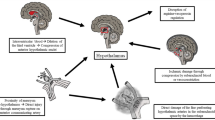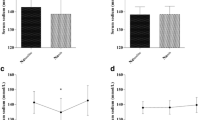Summary
To prevent symptomatic cerebral vasospasm, we have used hypervolaemia (HV) or volume expansion in patients with aneurysmal subarachnoid haemorrhage (SAH) in recent years. In these patients we could not perform effective fluid and sodium (Na) replacement because of rapid and overwhelming water and Na loss. Although this phenomenon is characteristic under hypervolaemic states, we regard it important to elucidate the mechanism underlying initiation of vasospasm after aneurysmal SAH. Patients with aneurysmal SAH, operated on within 24 hours of onset, were analysed prospectively. We selected 17 patients in good pre-operative condition. Intravascular volume expansion was accomplished with plasma fractionate or albumin and crystalloid solutions in all patients. We divided the 17 patients into two groups; symptomatic spasm group (S-group) consisting of 4 cases developing transient ischaemic symptoms and non-symptomatic spasm group (NS-group) consisting of 13 cases. In S-group, rapid and marked natriuresis developed characteristically before the onset of ischaemic symptoms. The differences in daily Na balance between the two groups were significant on the 3rd and 5th days (p < 0.05). The mean cumulative Na balance in S-group during the 10 days of the study (−375 ± 159 mEg) was higher than that of NS-group (−24.4 ± 225 mEq) (p < 0.05). Rapid natriuresis preceded the development of ischaemic symptoms, and was important as a trigger for symptomatic vasospasm after SAH. We considered that hormonal disorders were implicated in this phenomenon, and atrial natriuretic peptide (ANP), antidiuretic hormone (ADH), renin, and aldosterone were each measured three times during the period, with no significant differences, found between the two groups. It was speculated that another potent natriuretic factor, similar to ANP, induced a rapid selective natriuresis resulting in symptomatic vasospasm.
Similar content being viewed by others
References
Awad IA, Carter LP, Spetzler RF, Medina M, Williams Jr FW (1987) Clinical vasospasm after subarachnoid hemorrhage: response to hypervolemic hemodilution and arterial hypertension. Stroke 18: 365–372
Diringer MN, Ladenson PW, Stern BJ, Schleimer J, Hanley DF (1988) Plasma atrial natriuretic factor and subarachnoid hemorrhage. Stroke 19: 1119–1124
Dilinger MN, Lim JS, Kirsch JR, Hanley DF (1991) Suprasellar and intraventricular blood predict elevated plasma atrial natriuretic factor in subarachnoid hemorrhage. Stroke 22: 577–581
Hasan D, Vermeulen M, Wijidicks EFM, Hijdra A, Gijn JV (1989) Effect of fluid intake and antihypertensive treatment on cerebral ischemia after subarachnoid hemorrhage. Stroke 20: 1511–1515
Joint RJ, Afifi A, Harbison AJ (1965) Hyponatremia in subarachnoid hemorrhage. Arch Neurol 13: 633–638
Kassell NF, Peerless SJ, Durward QJ, Beck DW, Drake CG, Adams HP (1982) Treatment of ischemic deficits from vasospasm with intravascular volume expansion and induced arterial hypertension. Neurosurgery 11: 337–343
Keller TS, McGillicuddy JE, LaBond VA, Kindt GW (1985) Modification of focal cerebral ischemia by cardiac output augmentation. J Surg Res 39: 420–432
Kosnik EJ, Hunt WE (1976) Postoperative hypertension in the management of patients with intracranial arterial aneurysm. J Neurosurg 45: 148–154
Kudo T, Suzuki S, Iwabuchi T (1981) Importance of monitoring the circulating blood volume in patients with cerebral vasospasm after subarachnoid hemorrhage. Neurosurgery 9: 514–520
Maroon JC, Nelson PB (1979) Hypovolemia in patients with subarachnoid hemorrhage: therapeutic implications. Neurosurgery 4: 223–226
Nelson PB, Seif SM, Maroon JC, Robinson AG (1984) Hypotremia and natriuresis following subarachnoid hemorrhage in a monkey model. J Neurosurg 60: 233–237
Pritz MB (1981) Treatment of cerebral vasospasm, usefulness of Swan-Ganz catheter monitoring of volume expansion. Surg Neurol 21: 239–244
Sivakumar V, Rajshekhar V, Chandy MJ (1994) Management of neurosurgical patients with hyponatremia and natriuresis. Neurosurgery 34: 269–274
Solomon RA, Post KD, McMurthy JG (1984) Depression of circulating blood volume in patients after subarachnoid hemorrhage. Neurosurgery 15: 354–360
Wijidicks EFM, Vermeulen M, Hijdra A, van Gin J (1985) Hyponatremia and cerebral infarction in patients with ruptured intracranial aneurysms. Ann Neurol 17: 137–140
Wijidicks EFM, Ropper AH, Hunnicutt EJ, Richardson GS, Nathanson JA (1991) Atrial natriuretic factor and salt wasting after aneurysmal subarachnoid hemorrhage. Stroke 22: 1519–1524
Wood JH, Simeone FA, Fink EA, Goldon MA (1983) Hypervolemic hemodilution in experimental focal cerebral ischemia. J Neurosurg 59: 500–509
Author information
Authors and Affiliations
Rights and permissions
About this article
Cite this article
Okuchi, K., Fujioka, M., Fujikawa, A. et al. Rapid natriuresis and preventive hypervolaemia for symptomatic vasospasm after subarachnoid haemorrhage. Acta neurochir 138, 951–957 (1996). https://doi.org/10.1007/BF01411284
Issue Date:
DOI: https://doi.org/10.1007/BF01411284




